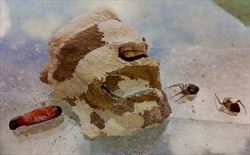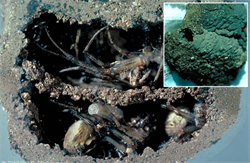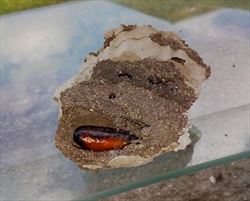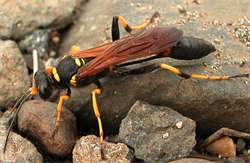- Widespread. In several Pacific island countries.
- A nuisance pest of human beings: (i) nests built in buildings; (ii) wasps can sting and (iii) preying on spiders.
- Solitary wasp, building tubes of mud containing up to 25 cells in which paralysed spiders are packed as food for larvae, and where pupae develop. Adults, black with yellow markings, about 25 mm long (females larger than males), with thin, black ‘petiole’ – part between thorax and abdomen. Adults feed on nectar.
- Spread: short distances on the wing, and further as a stowaway on planes and ships as adults or as larvae/pupae in mud nests.
- Biosecurity: (i) stowaway wasps risk outbreaks, such as that of Rotuma, where the wasp has been newly introduced; and (ii) loss of diversity of spiders with potential outbreaks of the insects previously controlled by them.
- Biocontrol: birds predate wasps, but none have been identified in Pacific island countries.
- Cultural control: remove nests made inside building by hand using knife or paint scraper; close windows, blinds or curtains; remove spider webs and use oils to repel spiders in houses; attract birds to gardens to prey on wasps feeding on nectar; coat inside of water-filled plastic bottles with jam to trap wasps.
- Chemical control: use drops or sprays of peppermint oil (50:50 with water) to repel mud-daubers.
Pacific Pests, Pathogens and Weeds - Online edition
Pacific Pests, Pathogens, Weeds & Pesticides
Mud-dauber wasp (534)
Yellow-legged mud-dauber wasp. It is also known as the back-and-yellow mud-dauber, black-wasted mud-dauber.
Scelipohron caementarium; previously, it was known as Sphex carmentarium. It belongs to the Sphecidae. (An outbreak in Rotuma, Fiji, has occurred recently, but identification of the mud-dauber species has not been officially authenticated).
AUTHOR Grahame Jackson and Mani Mua
Information from Ramage T, et al. (2015) The Aculeata id French Polynesia. III. Sphecidae, with the record of three new species for the Society Islands (Hymenoptera). Bulletin de la Societe entomogique de France 120(2): 157-163. Sceliphron caementarium. Wikipedia. (https://en.wikipedia.org/wiki/Sceliphron_caementarium); and from Powell E, Taylor L (2021) Back and yellow mud dauber (Sceliphron caementarium). Featured Creatures. Florida Department of Agriculture and Consumer Services, and University of Florida. (https://entnemdept.ufl.edu/creatures/MISC/WASPS/Sceliphron_caementarium.htm). Photos 1-4 Gerald McCormack. Cook Islands biodiversit. (http://cookislands.bishopmuseum.org/).
Produced with support from the Australian Centre for International Agricultural Research under project HORT/2016/185: Responding to emerging pest and disease threats to horticulture in the Pacific islands, implemented by the University of Queensland, in association with the Pacific Community.









